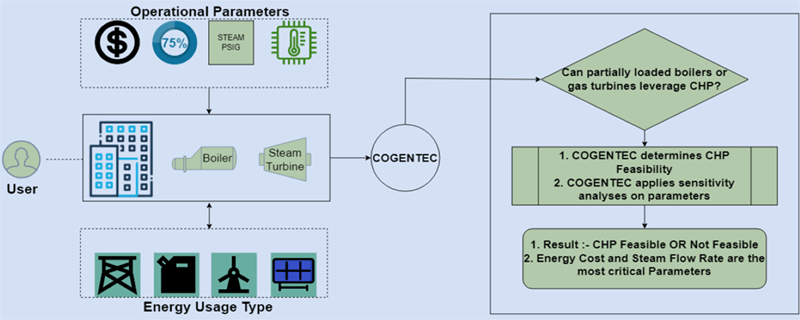 Open Access
Open Access
ARTICLE
Evaluation of Process and Economic Feasibility of Implementing a Topping Cycle Cogeneration
Department of Industrial & Management Systems Engineering, West Virginia University, Morgantown, 26506, USA
* Corresponding Author: Unique Karki. Email:
Energy Engineering 2023, 120(2), 345-365. https://doi.org/10.32604/ee.2023.025600
Received 21 July 2022; Accepted 09 October 2022; Issue published 29 November 2022
Abstract
Industrial applications that require steam for their end-use generally utilize steam boilers that are typically oversized, citing operations flexibility. Similarly, gas turbine-based power plants corroborate a gas turbine system that may eventually relieve the usable exhaust into the atmosphere. This study explores the economic and technical feasibility of a topping cycle combined heat and power (CHP) system. It does so by leveraging a partially loaded boiler or gas turbine by increasing its unused load to generate steam and heat for subsequent usage. To this end, a decision support tool (COGENTEC) was developed, which emulates a given facility’s boiler or gas-turbine system, and its operational parameters with the application of steam turbines. The tool provides necessary insights into the most appropriate parameters that enable a CHP system to be technically and economically advantageous. Based on input variables such as boiler-rated capacity, steam pressure, steam temperature, and existing boiler load, among others, COGENTEC designs a topping cycle CHP system to inform a user whether this system is feasible in their facility or not. If applicable, the tool assists the user to realize the point of break-even (fuel cost incurred and cost savings) at the desired steam flow rate. It also conducts sensitivity analyses between energy usage, cost savings, and payback on the investment of the operating parameters to understand the relationship between relevant variables. By utilizing parameters from a pulp and paper manufacturing facility, the research determines that the fuel cost, electricity cost, and steam flow rate are the most important parameters for the feasibility of the system with a desirable payback on the investment.Graphic Abstract

Keywords
Cite This Article
 Copyright © 2023 The Author(s). Published by Tech Science Press.
Copyright © 2023 The Author(s). Published by Tech Science Press.This work is licensed under a Creative Commons Attribution 4.0 International License , which permits unrestricted use, distribution, and reproduction in any medium, provided the original work is properly cited.


 Submit a Paper
Submit a Paper Propose a Special lssue
Propose a Special lssue View Full Text
View Full Text Download PDF
Download PDF Downloads
Downloads
 Citation Tools
Citation Tools